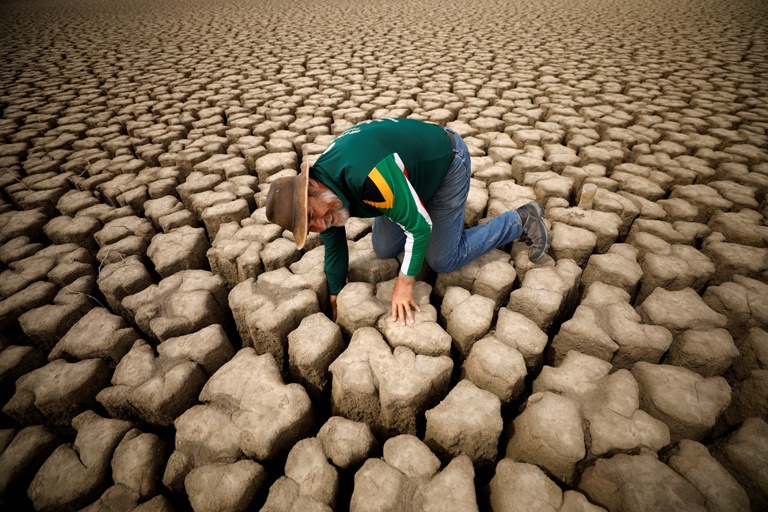
South Africa’s Karoo Drills and Prays as Taps Run Dry
South Africa’s Karoo region has always been parched – it means land of thirst in the language of its earliest inhabitants, the Khoisan hunter gatherers. Yet nothing prepared residents of its oldest town, Graaff-Reinet, for their worst drought in more than a century. As the dry spell entered its fourth year, tap water turned brown […]

South Africa’s Karoo region has always been parched – it means land of thirst in the language of its earliest inhabitants, the Khoisan hunter gatherers.

Yet nothing prepared residents of its oldest town, Graaff-Reinet, for their worst drought in more than a century.

As the dry spell entered its fourth year, tap water turned brown and smelled like rotting fish.
When the water behind the Nqweba Dam dried up, depositing tens of thousands of dead fish onto cracked earth, queues began forming at municipal bore holes and farm animals died in their hundreds.

The bleak choices facing millions of people in drought-stricken southern Africa – whether to flush toilets or not, or to keep animals alive or let them die – could soon be faced by other places on a warming planet with shrinking water supplies.

“This area is dry but our taps have never been completely empty. Never,” said Bukelwa Booysen, who has had to send staff in search of borehole water for her school for disabled children, and send the kids home when they can’t find any.

An abnormally hot summer with rainfall 75% below average, according to the U.S. National Oceanic and Atmospheric Administration, has struck the whole region.
The United Nations says 45 million people in southern Africa face hunger.
‘WHEN IT RUNS OUT’
Bushes and trees clinging to the Karoo’s rocky ravines are withered and grey – even hardy acacia thorns are dying. Signs mark rivers that are now dry beds.

At one farm, Gerrie Snyman, 65, was feeding grain to sheep and goats that couldn’t find pasture.

More than a third of his couple-thousand goats and sheep had either died or been sold this year.
His 80 cows were now 15. He loaded a calf that was starving – its mother had stopped producing milk – onto his truck to take home and shoot.
A friend had shot himself dead after his animals died of thirst.

“We are grateful to the Almighty for our borehole water,” he said. “We don’t know what we’ll do when it runs out.”
When Cape Town’s drinking water supply nearly ran dry 18 months ag, it made international headlines with its ‘Day Zero’ deadline, and authorities rationed water. Yet the Karoo is long past water rationing.
For Valentia Esho, 45, an unemployed mother of seven in the township of Umazisakhe, it means letting her toilet fill up instead of flushing, never washing clothes and only washing plates that stink.
Water is just for drinking.

“The house is really smelling,” she said, inside her one-room brick-and-tin home. “Everyone is paining from stomach aches and diarrhoea.”
In another township, Asherville, where wind kicked up dust devils, school headmaster Basil Vaaltyn was overseeing water distribution from a truck.
He’d done everything to cut down on his usage: “I’m down to a minute showering instead of two.” His wife saves dirty dishwater to fill the cistern.

A spokesman for the municipality said it was drilling boreholes, installing pipelines and building an 18-million-litre reservoir, adding: “Usage of water is still very high. The community is requested to use water sparingly.”
‘THERE’S WATER HERE’

With municipal authorities overwhelmed, South African charity Gift of the Givers is trucking water to townships and drilling boreholes.
Gideon Groenewald, a geohydrologist for the charity, uses science and spirituality to look for groundwater. When he was growing up on a farm, he used to dowse with wet twigs. Nowadays he prefers magnetic detectors.

“I open Google maps and look for the lines of trees. I ask God in prayer which lines hold water, then I go down to that GPS location,” he said while a forked stick turned in his hand over an arid patch of shrubs.
“You see the stick moving where the magnetic field is? There’s water here,” he continued. “It’s pure science.”
The charity has drilled 1,800 boreholes in the past three years, Groenewald said, only a third of them dry.
But Louise Stafford, water director for the Nature Conservancy in South Africa, urged caution with boreholes, because groundwater is a finite resource.
Water-intensive agriculture like citrus farms can make droughts worse, she said, and leaky pipes are losing a billion litres a year – problems Water Minister Lindiwe Sisulu pledged to tackle in a new water masterplan she delivered on Thursday.

One Sunday, as clouds formed over Graaff-Reinet, its Assembly Church prayed. The clouds spat but didn’t pour.
“We pray for God to open heaven and send rain,” Pastor Dolan Cochrane said.
The congregation bowed.

“Lord,” Cochrane continued. “We know that, in your time, you will come to our rescue.”
(Editing by Giles Elgood)
